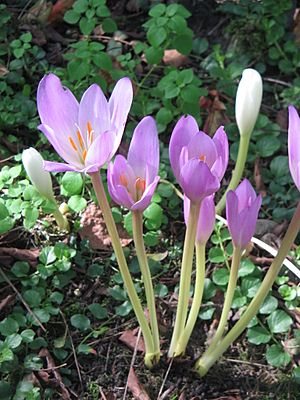Colchicum facts for kids
Quick facts for kids Colchicum |
|
|---|---|
 |
|
| Colchicum speciosum | |
| Scientific classification |
|
| Kingdom: | Plantae |
| Clade: | Tracheophytes |
| Clade: | Angiosperms |
| Clade: | Monocots |
| Order: | Liliales |
| Family: | Colchicaceae |
| Genus: | Colchicum L. |
| Synonyms | |
|
|
Colchicum is a group of about 160 different species of perennial flowering plants. These plants grow from special underground stems called corms, which look a bit like bulbs. Colchicum plants belong to the Colchicaceae plant family. You can find them growing naturally in West Asia, Europe, parts of the Mediterranean coast, and down the East African coast to South Africa.
A cool fact about Colchicum flowers is that their ovary (where seeds are made) is underground. This means the styles (parts of the flower that collect pollen) are super long. They can be more than 10 centimeters (about 4 inches) long! It's important to know that all Colchicum plants are poisonous.
Contents
What are the common names for Colchicum?
People often call Colchicum plants by names like autumn crocus, meadow saffron, or naked lady. These names are used for the whole group of plants or for many of its specific types. They are called "naked" because their crocus-like flowers pop up in late summer or autumn. This happens long before their strap-like leaves appear in the spring.
How to tell Colchicum from Crocus
Colchicum and Crocus flowers look very similar. It's easy to mix them up, especially since some crocuses also bloom in the autumn. However, there are a few key differences.
- Colchicum flowers have 3 styles and 6 stamens (the parts that produce pollen).
- Crocus flowers have only 1 style and 3 stamens.
Also, their underground corms are different. A Colchicum corm is usually an irregular shape. A Crocus corm is more like a flattened ball. Remember, Crocus plants are in the Iris Family, called Iridaceae.
Where does the name Colchicum come from?
The name Colchicum comes from an old Greek word, Κολχίς (Colchis). This was the name for a region in modern-day Georgia (in the Caucasus mountains). In Greek mythology, Colchis was a famous place. It's where the Argonauts traveled to find the golden fleece. This is also where Jason met the sorceress Medea. Scholars think the Greek name Colchis might come from an older language called Urartian.
Where do Colchicum plants grow?
Colchicum melanthioides is a well-known type of Colchicum from tropical areas. Unlike most Colchicum plants that grow in cooler places, its flowers and leaves grow at the same time. Its white flowers usually grow in a small cluster. This cluster is surrounded by white leaf-like parts called bracts.
Some close relatives, like Colchicum scabromarginatum and Colchicum coloratum, have flowers with very short stems. These plants might even be pollinated by small animals like rodents!
Growing Colchicum in your garden
Many types of Colchicum that grow in cooler climates are popular garden flowers. People grow them because they are beautiful. Here are some of the types you might find in gardens:
- C. × agrippinum
- C. autumnale
- C. × byzantinum
- C. cilicicum
- C. lusitanum
- C. speciosum
- C. tenorei
There are also many special types created by gardeners, called cultivars, and hybrids. These have unique colors and shapes. Some examples include:
- C. 'Dick Trotter' (violet with a white center)
- C. 'Disraeli' (purple white)
- C. 'Giant' (red with a white center)
- C. 'Harlekijn' (white with a purple band)
- C. 'Lilac Wonder' (lilac)
- C. 'Pink Goblet'agm (violet-purple)
- C. 'Poseidon' (purple)
- C. 'Rosy Dawn'agm (rose pink)
- C. 'Violet Queen' (purple)
- C. 'Waterlily'agm (double, lilac-pink)
The ones marked with agm have won an important award. It's called the Royal Horticultural Society's Award of Garden Merit. This award means they are excellent plants for gardens.
In the United Kingdom, there's a special collection of Colchicum plants. It's called the NCCPG National Plant Collection. You can find it at Felbrigg Hall in Norfolk.
Medicinal uses and why Colchicum is poisonous
Colchicum plants contain a substance called alkaloid colchicine. This substance is very toxic, meaning it's poisonous in large amounts. However, in small, controlled amounts, colchicine is used in medicine. Doctors use it to treat certain health problems like gout and Familial Mediterranean fever. People in traditional medicine used the roots and seeds of these plants. They likely did this because they knew about the effects of this drug.
It's very important to remember that the leaves, corms, and seeds of Colchicum plants are all poisonous. The type of Colchicum that has the most dangerous amount of colchicine is C. autumnale. Never eat any part of these plants.
Images for kids
See also
 In Spanish: Colchicum para niños
In Spanish: Colchicum para niños


